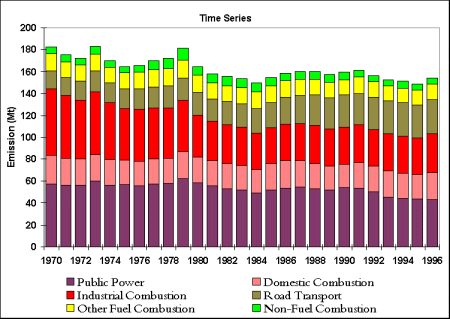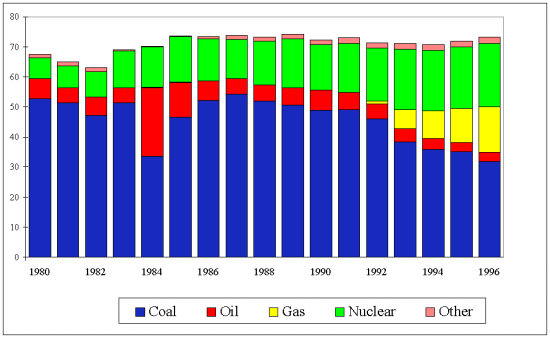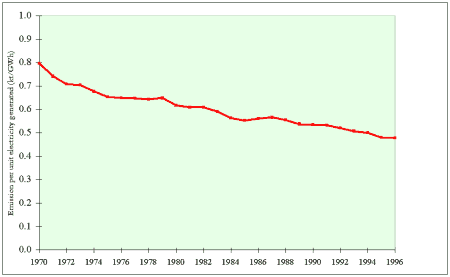



2.2 CO2 Emission Estimates
2.2.1 Total CO2 emissions
Carbon dioxide emissions have reduced by around 15% since 1970, as shown in Figure 2.2. However, this decline has not been steady, and peaks were observed in 1973 and 1979 which were due, to the state of the economy, high oil prices and severe winters in these years. Emissions fell again during the early eighties reflecting the recession during this period and the coal miners strike of 1984. Since the mid-1980s the emissions profile has been much smoother showing an overall reduction in emissions.
The major emissions of carbon dioxide arise from the combustion of fossil fuels in power generation, and the transport, domestic and industrial sectors (Figure 2.2, Table 2.2). The level of emissions depends on the fuel mix and the fuel consumption data. Details of UK fuel consumption are given annually in the Department of Trade and Industry's Digest of United Kingdom Energy Statistics (DTI, 1997). The fuel consumption data used to calculate the pollutant emission totals in the NAEI is given in Table 2.3; fuels which are used as feedstocks are omitted (principally natural gas used for the production of ammonia, methanol and acetic acid and some use of LPG and OPG in petrochemical plants).
Table 2.2 UK Emissions of Carbon Dioxide as Carbon by UNECE1 Source Category and Fuel (Mt)
| 1970 | 1975 | 1980 | 1985 | 1990 | 1993 | 1994 | 1995 | 1996 | 1996% | |
| By UNECE Source | ||||||||||
| Comb. in Energy Prod & Transf. | ||||||||||
| Power Plant | 57.0 | 56.5 | 58.3 | 51.9 | 54.1 | 45.5 | 44.3 | 44.0 | 43.4 | 28% |
| Petroleum Refining Plants | 5.2 | 5.2 | 5.6 | 4.7 | 4.9 | 5.6 | 5.6 | 5.7 | 5.8 | 4% |
| Other Combs. & Trans. | 8.2 | 3.5 | 2.8 | 3.9 | 3.9 | 3.9 | 4.4 | 4.7 | 5.2 | 3% |
| Comb. in Comm/Inst/Resid/Agri | ||||||||||
| Domestic | 26.5 | 22.6 | 23.3 | 24.2 | 21.5 | 24.2 | 22.9 | 21.7 | 24.7 | 16% |
| Other | 10.3 | 8.8 | 9.9 | 9.9 | 8.4 | 8.8 | 8.7 | 8.8 | 9.4 | 6% |
| Combustion in Industry | 47.7 | 38.4 | 30.0 | 24.0 | 24.6 | 23.9 | 24.0 | 23.5 | 23.9 | 15% |
| Production Processes | 4.9 | 5.1 | 4.2 | 4.7 | 4.0 | 2.8 | 3.3 | 3.1 | 3.2 | 2% |
| Extr./Distrib. of Fossil Fuels | 0.1 | 0.1 | 0.1 | 0.3 | 0.4 | 0.1 | 0.2 | 0.2 | 0.2 | 0% |
| Solvent Use | 0.0 | 0.0 | 0.0 | 0.0 | 0.0 | 0.0 | 0.0 | 0.0 | 0.0 | 0% |
| Road Transport | ||||||||||
| DERV | 4.3 | 4.6 | 5.0 | 6.1 | 9.1 | 10.1 | 11.1 | 11.5 | 12.3 | 8% |
| Petrol | 11.7 | 13.3 | 15.9 | 17.1 | 20.4 | 20.0 | 19.2 | 18.4 | 18.8 | 12% |
| Other Transp & Mach. | ||||||||||
| Off-Road | 2.5 | 2.4 | 2.1 | 2.0 | 1.7 | 1.8 | 1.7 | 1.6 | 1.7 | 1% |
| Other2 | 3.3 | 3.4 | 3.4 | 3.4 | 3.6 | 3.5 | 3.3 | 3.2 | 3.2 | 2% |
| Waste Treatment & Disp. | 0.2 | 0.3 | 3.3 | 2.1 | 2.2 | 1.9 | 2.5 | 1.8 | 1.9 | 1% |
| Agricult/Forest/Land Use Change | 0.5 | 0.5 | 0.4 | 0.5 | 0.4 | 0.3 | 0.3 | 0.4 | 0.4 | 0% |
| Nature | 0.0 | 0.0 | 0.0 | 0.0 | 0.0 | 0.0 | 0.0 | 0.0 | 0.0 | 0% |
| By Fuel | ||||||||||
| Solid | 90.3 | 67.5 | 70.6 | 60.8 | 61.4 | 49.4 | 46.1 | 42.9 | 39.9 | 26% |
| Petroleum | 67.5 | 65.6 | 58.0 | 54.5 | 56.6 | 56.5 | 55.3 | 53.9 | 55.1 | 36% |
| Gas | 20.4 | 27.6 | 29.6 | 34.1 | 35.7 | 41.8 | 44.5 | 47.2 | 54.2 | 35% |
| Non-fuel | 4.0 | 4.1 | 6.4 | 5.3 | 5.7 | 4.6 | 5.4 | 4.9 | 5.0 | 3% |
| Total | 182.3 | 164.8 | 164.5 | 154.7 | 159.4 | 152.3 | 151.4 | 148.9 | 154.2 | 100% |

The electricity supply industry is the major consumer of fossil fuels, and hence the major source of carbon dioxide emissions in the UK (Tables 2.2 and 2.3). There have been significant changes in the generating mix between 1980 and 1996, as shown in Figure 2.3. The level of CO2 emissions is determined by both the fuel mix and the generating technology used. During the 1970s the electricity supply industry was dominated by coal and fuel oil fired thermal power stations, and coal and oil consumption increased to meet the rising demand for electricity. The use of coal for generation peaked in 1980 at 89.6 Mt and has subsequently declined. The fall has not been steady showing minima in 1982 and 1984 due to recession in the early 1980s and the miners strike. During the late 1980s and early 1990s, the closure of inefficient plant led to an overall increase in the thermal efficiency of the conventional thermal power plants, and the contribution of nuclear power generation increased with the greater utilisation of existing nuclear plants and the commissioning of Sizewell B in 1991. The use of oil generation peaked in 1972 and apart from increased consumption during the miners strike of 1984 has been in decline ever since. Two oil-fired stations have been converted to burn Orimulsion® (an emulsion of bitumen and water) although this practice is in decline, largely on environmental grounds. More recently, the privatisation of the power industry has resulted in a move away from coal and oil generation towards combined cycle gas turbines (CCGT). The use of gas in power generation has increased by a factor of 29 since 1991. Further increases are expected as more CCGT stations come on line.
Table 2.3 UK Fuel Consumption
| Fuel | Consumer | Units | 1970 | 1980 | 1985 | 1990 | 1991 | 1992 | 1993 | 1994 | 1995 | 1996 |
| Coal | Major Power Producers | kt | 77216 | 89569 | 73940 | 82555 | 82021 | 76989 | 64096 | 60650 | 57943 | 53423 |
| Coal | Industry | kt | 21540 | 8503 | 7806 | 7856 | 8059 | 8140 | 7358 | 6726 | 6146 | 5117 |
| Coal | Domestic | kt | 20142 | 8946 | 8636 | 4239 | 4778 | 4156 | 4639 | 3901 | 2690 | 2706 |
| Coal | Others | kt | 37888 | 16419 | 15005 | 13607 | 12656 | 11295 | 10634 | 10506 | 10169 | 10157 |
| Other Solid Fuels | All Consumers | kt | 25795 | 9793 | 11272 | 10298 | 9806 | 9416 | 9216 | 9019 | 8822 | 9534 |
| Motor Spirit | Road Transport | kt | 14235 | 19145 | 20403 | 24312 | 24021 | 24044 | 23766 | 22843 | 21953 | 22409 |
| Gas Oil | Road Transport | kt | 5035 | 5854 | 7106 | 10652 | 10694 | 11132 | 11806 | 12914 | 13457 | 14365 |
| Gas Oil | Industry | kt | 5059 | 4706 | 3452 | 2970 | 2901 | 2856 | 2918 | 2933 | 2846 | 3041 |
| Gas Oil | Others | kt | 7746 | 7842 | 7456 | 6216 | 6325 | 6256 | 6024 | 5773 | 5509 | 5820 |
| Fuel Oil | Major Power Producers | kt | 11903 | 6336 | 9509 | 6358 | 5542 | 4152 | 3272 | 2337 | 2225 | 2217 |
| Fuel Oil | Refineries | kt | 3533 | 3526 | 2188 | 2020 | 2217 | 2263 | 2356 | 2448 | 2318 | 2300 |
| Fuel Oil | Industry | kt | 20888 | 10594 | 4683 | 4402 | 4866 | 4833 | 4783 | 4356 | 3275 | 2699 |
| Fuel Oil | Others | kt | 7514 | 3882 | 2721 | 2479 | 2413 | 2517 | 2622 | 2470 | 2553 | 2528 |
| Orimulsion | Major Power Producers | kt | 0 | 0 | 0 | 155 | 418 | 1286 | 1416 | 1227 | 1276 | 872 |
| Burning Oil | Domestic | kt | 2018 | 1699 | 1403 | 1567 | 1825 | 1914 | 2037 | 2058 | 2101 | 2551 |
| Burning Oil | Others | kt | 4033 | 498 | 533 | 484 | 554 | 558 | 587 | 597 | 673 | 780 |
| Aviation Turbine Fuel | Air Transport | kt | 3481 | 4728 | 5036 | 6615 | 6200 | 6693 | 7133 | 7313 | 7689 | 8081 |
| Petroleum Gases | Refineries | GWh | 29336 | 31622 | 36253 | 42988 | 42460 | 42056 | 44863 | 46206 | 47897 | 49591 |
| Petroleum Gases | Others | GWh | 20515 | 18317 | 15650 | 15134 | 17655 | 15840 | 16333 | 17731 | 17754 | 19410 |
| Other Petroleum Prod. | All Consumers | kt | 672 | 1076 | 955 | 1023 | 1116 | 1122 | 1153 | 1022 | 1179 | 1172 |
| Natural Gas | Major Power Producers | GWh | 1758 | 1612 | 3693 | 88 | 202 | 11600 | 72901 | 105670 | 133066 | 176704 |
| Natural Gas | Industry | GWh | 20808 | 193896 | 200783 | 205602 | 200738 | 192685 | 198257 | 221741 | 232128 | 256472 |
| Natural Gas | Domestic | GWh | 18376 | 246766 | 283517 | 300398 | 333954 | 330115 | 340168 | 329705 | 326012 | 375834 |
| Natural Gas | Others | GWh | 64651 | 64124 | 83672 | 88546 | 104580 | 105470 | 105185 | 106797 | 116962 | 128944 |
| Other Gases | All Consumers | GWh | 205413 | 33000 | 36810 | 39781 | 38105 | 36026 | 35215 | 36214 | 36346 | 38328 |

The effect of these changes in the power sector are clearly reflected in the carbon dioxide emissions. Since 1970 there has been an increase in the electricity generated of around 42% but a large decrease in emissions of around 24%. More significantly, emissions have decreased by 20% between 1990 and 1996. This is due specifically to:

The domestic use of coal (including anthracite) shows an overall decline between 1970 and 1996, falling by 85%; domestic use of smokeless solid fuels (including coke) has also fallen significantly by around 77%. This reflects a trend away from solid fuels towards alternatives such as electricity and gas in sectors. Over the same period the domestic use of gas has increased by over a factor of 3.6.
2.2.4 Industrial
The industrial emissions have fallen by 50% since 1970. The curve exhibits peaks in 1973, 1979, and 1988 which are due in part to the cold winters in these years but mainly to the various levels of economic activity. According to DTI (1997), industrial energy consumption has declined since 1970 by 40% reflecting the decline in a number of the energy intensive industries and improvements in energy efficiency. Over this period, there has also been a marked move away from coal and oil consumption to gas and to a lesser extent electricity.
2.2.5 Transport
Total emissions from the transport sector have steadily increased since 1970. Of these road transport emissions have risen by 94% and currently accounts for around 86% of the total transport emissions or 20% of the total UK's carbon dioxide emissions. Although emissions fell a little during 1974-75 reflecting the increase in motor fuel prices after the oil crisis. The steady increase in fuel use by most forms of transport reflects the increased demand for transport in the UK between 1970 and 1996. The increased use of private motor vehicles has resulted in a 57% increase in the consumption of petrol. However, petrol consumption has declined by 8% since 1990 which is a result of the increase in popularity of diesel cars. Increased use of goods vehicles is reflected in the increase in DERV consumption by a factor of 2.9 since 1970.
2.2.6 Agriculture/forests/land use change
The effect of changing land-use can result in either net emission or net absorption of CO2 , particularly on a global scale. For example, forest clearing for agricultural use could be a net source of CO2. Recently the Intergovernmental Panel on Climate Change agreed new guidelines for preparing national inventories (IPCC, 1997). Land use change and forestry estimates are included in the UK Greenhouse Gas Inventory (Salway, 1998) for the years 1990-96. The estimates have yet to be included in the NAEI which covers the longer period 1970-1996. For comparative purposes the land use change estimates of carbon emissions and removals are summarised in Table 2.4 (Milne, 1997). The new guidelines for Land Use Change and Forestry include emissions from liming of soils under 'D CO2 Emissions and Removals from Soils'. These are already included in the NAEI under Agricultural Soils.
| Sources | Emissions | Removals |
| A Changes in Forest and Other Woody Biomass Stocks | 10624 | |
| B Forest and Grassland conversion 2 | 24789 | |
| C Abandonment of Managed Lands 3 | 7681 | |
| D CO2 Emissions and Removals from Soil 4 | 1515 | |
| E Other 5 | 3667 | 367 |
| Total | 29971 | 18672 |